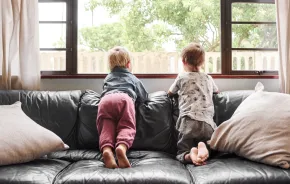
Photo:
iStock
Editor’s note: This article was sponsored by Mary Bridge Children’s
Children who are lonely don’t always act sad or hopeless. Sometimes, there might be less obvious indicators, such as a child completely obsessed with technology.
That was the case with a middle schooler, who was referred to school social workers for behavioral outbursts, cursing and social struggles, explained licensed clinical social worker Kianna Carter. The more she learned about their story, the more she understood that their excessive technology use was masking social isolation.
“They didn’t identify as lonely,” says Carter, who supervises the youth engagement services for Mary Bridge Children’s Hospital. “Kids often don’t realize it.”
Carter and her team were able to work with that middle schooler, helping them connect with peers and improve their school interactions. That individual experience, though, underscores how widespread hidden loneliness is among today’s adolescents. The solitude of the pandemic years is still having lasting reverberations today. At the same time, youth are increasingly reliant on technology for social interactions and enjoyment. Often what looks like bad behavior, zoning out or social struggles is driven by these isolating experiences.
“Kids are spending excessive time alone and drawing back from activities they used to enjoy, which adds to this overall sense of disconnectedness,” she says.
What causes loneliness?
Loneliness is a persistent problem for Americans today, so much so that the former U.S. surgeon general issued a 2023 report on the country’s “epidemic of loneliness.” That isolation takes a troubling toll on people’s physical and mental health, the report found.
The pandemic worsened already growing rates of loneliness among youth. Today, social workers like Carter are still seeing the lingering impact of the pandemic on children’s social development and connections. Today’s adolescents had years of learning social norms taken away from them. Those experiences are coupled with growing dependence on technology as means for interacting.
Tech devices such as cell phones and personal computers can be a double-edged sword, she says. On one hand, the platforms can connect people. But those feelings of connection can be fleeting, leaving users feeling even more alone.
“There is a lack of humanity compared to actually sitting down with friends,” she explains.
Some adolescents — like the middle schooler she described — develop a dependency on devices that can heighten dysregulation. Those struggles carry over into peer interactions where children might show less patience and empathy.
“Frustration tolerance is at an all-time low,” she says. “We’re so used to getting things instantly. This can create barriers in terms of your social development and your ability to thrive.”
Identifying changes in your child
Since children may not understand these effects, it’s important for parents and caregivers to watch for less obvious signs of loneliness.
These indicators might look different depending upon the child and personality. Even so, a common characteristic is a change in behaviors. For example, they might be spending additional time on devices or sleeping excessively. Others might experience changes in appetite, act withdrawn or be less interested in family connections. Still others might exhibit more emotional intensity.
“Parents know their kids best, but we want to pay attention to whether there is an excessive amount of time they want to spend alone,” she says. “Pay attention to what your kid is like at baseline and if this behavior is getting away from that.”
A simple first step to address loneliness
If you suspect your child might be experiencing loneliness, a tried-and-true method may be the best approach: Be open and honest.
Carter suggests addressing what you’ve observed in a direct way, such as: “I’ve noticed you’re cooped up in your room. You’re not coming down for family game night, and you don’t want to play soccer anymore. I want to check in. Is everything OK? What’s going on internally for you?”
A transparent conversation like that can open the door for a child to self-reflect — and possibly unload some confusing and intense feelings. Listen with interest, not judgment, she advises.
“Coming from a place of curiosity can ebb that defensiveness we see from adolescents sometimes,” she says.
Even if that initial discussion doesn’t yield insights, establishing good rapport can lay the foundation for future discussions.
If your child does acknowledge feeling low, ask what you can do to support them. Parents and caregivers could offer some low-stakes way to engage such as taking the dog for a walk together, or going out for a pizza dinner. Even if they decline these offers, though, the open discussion itself can help ease that sense of isolation.
Parents can also model social interactions, creating organic moments for their children to socialize. Stopping to chat with a fellow parent during school pickup can give your child a chance to interact with peers in a low-stakes way.
“Create those easy-going moments,” she says. “When we model that behavior, it makes it easier for kids.”
If your efforts aren’t working and your child is experiencing persistent loneliness, consider seeking professional support such as therapy, she says. Professional support can also be important for caregivers since navigating these tough issues can feel isolating for them, too.
Set healthy limits on screens
Excessive technology use and social isolation often go hand in hand.
Children aren’t the best at limit setting, especially when it comes to technology. That’s why it’s important for parents to take a look at how their child is spending their free time. If technology use is interfering with in-person socializing or activities, household policies might need to be restructured.
In these conversations, explain why it’s important to have boundaries, especially when something is impeding one’s ability to thrive.
If the feelings of loneliness stem from social media use, consider a conversation to reflect on how these online comparisons can make people feel. Sharing your own feelings about watching “beautiful lives” play out on social media can provide a good opportunity for reflection and connection, Carter says.
Be creative with strategies
Amid today’s tech-intensive world, it can be hard to find balance. Along with limit-setting, work with your child to find equilibrium between enjoying technology and allowing time for real-world interactions.
Sometimes, the two might be intertwined. Take the example of the middle schooler who struggled with technology overuse and social isolation. The family of the child worked with Mary Bridge Children’s school support staff to find an activity that combined technology and socializing. They came up with a robotics club, where they could share their passions with peers. The success trickled over into the student’s school performance, where they now experience fewer outbursts and better social relationships.
“That club was a huge win,” Carter says. “There is hope and room for change.”
|
Sponsored by: |
|
|












